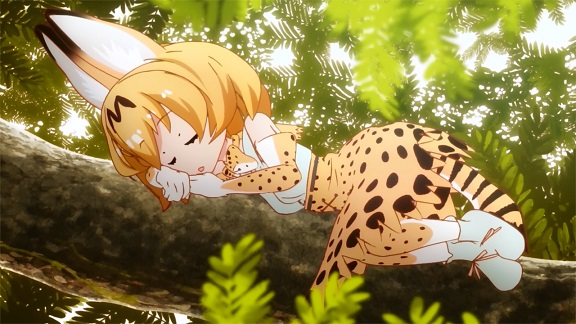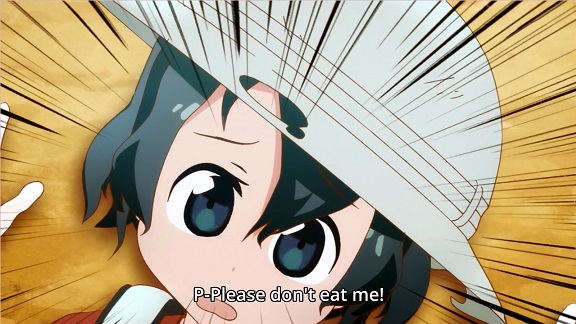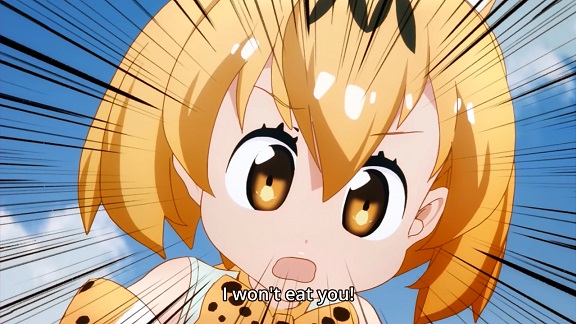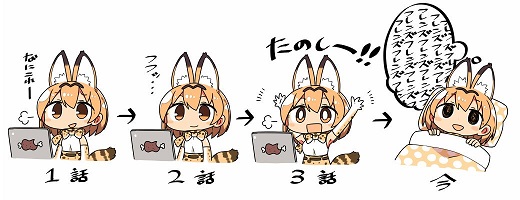How did the show with the lowest budget and the ugliest artwork and animation grow out to be the best series of winter 2017?
Lots of heart.

When Kemono Friends premièred in January, nobody thought anything about it. A spinoff to promote an already cancelled mobile game, created by a no name studio in CG, on barely any budget and a staff of at most a dozen people: why would you give it the time of day. Only because there are people who watch everything did it even got a small audience for its first episode, most of which dumped it immediately. But some kept watching and by episode three they were captured, as shown in the cartoon above that made the rounds of Japanese Twitter. And those viewers started spreading the gospel, first in Japan, then elsewhere as Kemono Friends became one of the very few anime series to become a runaway success purely through word of mouth.

At its heart Kemono Friends iss a simple and utterly sincere story about friendship and kindness. It starts with our two protagonists meeting, as Serval, asleep in a tree on the savannah, spots Kaban walking nearby and decides to stalk her in a game of hunter and prey. One chase scene later and they’re friends. It turns out Kaban has no idea how she got there, doesn’t know who or what she is even; it’s Serval who actually names her Kaban, after the bag (kaban) on her back and who explains the realities of life in Japari Park, how there are all sorts of animal based Friends like her. Because Kaban doesn’t know what kind of animal she is, Serval decides to help her and they go on a quest to find out her identity and where in the park she lives. They’re a good pair, Serval being easy going and athletic, Kaban being a worrywart (especially about the possibility of being eaten) but good at solving problems.

Serval and Kaban’s evolving friendship as they explore Japari Park and their encounters with other Friends is the heart of the story, but what really keeps up interest as the series progresses, is the mystery of Japari Park itself. Clearly something happened that put it in the half ruined, deserted state that it’s in when clearly it was meant as some sort of amusement park/zoo. What exactly happened is never made clear, but hints are dropped all through the series and putting them together is half the fun of the series. It’s here that the genius of the series lies, in that the way information is doled out is done brilliantly, just enough to keep it interesting without revealing the answer too quickly. It was this combination of an earnest story about friendship and kindness, at a time when we darn well needed it, with a well designed mysterious post-apocalyptic setting, that made Kemono Friends so popular through sheer word of mouth.
But of course capitalism can never leave anything alone. Thanks to studio Yaoyorozu and director Tatsuki, a low budget anime for a failed mobile game was transformed in a property that not only promised a second season, but also led to a new game being greenlit on the back of its succes. So no wonder that Kadokawa, the multimedia giant that was the lead in the Kemono Friends production committee fired Tatsuki and severed ties with the studio, because this sort of success must of course be punished. It immediately caused me to lose all interest in any possible sequel, if only not to reward companies who do things like this, but also because I have no trust that another studio could do as well with the series as Yaoyorozu.
This is the seventh post in this year’s twelve days of anime challenge. Tomorrow: a look at western fantasy in anime with Mahoutsukai no Yome & LWA.

No Comments